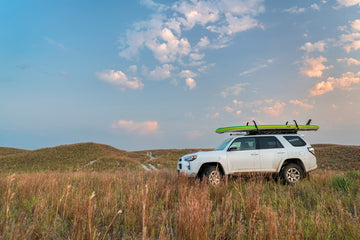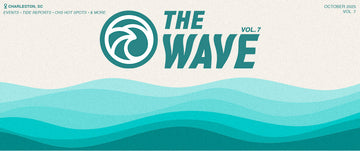A Beginner's Guide to Paddleboarding
Learning to paddleboard is just like learning to ride a bicycle. Okay, well, except without the helmet, unflattering bike shorts and asphalt that hurts when you fall because you can’t get out of your bike clips fast enough. Let’s rephrase that.
Learning to paddleboard offers the same main lesson as when you’re learning to ride a bike:
It’s not about if you’ll go down. It’s about when you’ll go down.
Yep. The first and foremost lesson for your stand-up paddleboard (SUP) is knowing you’re going to tumble off the board and into the water. Probably repeatedly. And usually in front of total strangers. So don’t sweat it. Don’t fret it. And above all else, don’t fight it.
Flailing your arms and screaming like a wounded chicken typically doesn’t get you very many points on the coolness scale (speaking from experience here).
Go with the fall. Embrace the splash. Then get back on the board and keep going.
Must-Have Paddleboard Stuff
Since falling off the board is inevitable at one time or another, the first rule of thumb is to make sure you’re equipped with everything you need to make the fall as pleasant as possible.
Life jacket: Technically known as a PFD, or personal floatation device, life jackets might make you think of toddler swimming lessons. But the U.S. Coast Guard requires them to be on board your board in open waters (since paddleboards are classified as vessels).
Kids must wear PFDs on a paddleboard in any type of water. Adults don’t have to. But you’re going to want to, especially if you don’t want to replace your expensive sunglasses. Life jackets ensure your head doesn’t go plunging beneath the water when you take those inevitable falls.
Leashes: Leashes consist of long, twisty cords with Velcro cuffs that attach things together that might otherwise float away. You want one around your ankle, attaching you to your board. If you're looking to go the extra mile, you want another one around your paddle, attaching your paddle to your board.
Dry bag: Optional, though most people would advise against leaving your phone in that hot oven of a car. A must-have if you’re taking anything on the board that can’t get soaking wet. I mean, why wouldn't you want photos anyway?
Paddle: You’ll need one paddle at a time on your board. But you may as well get two. Always good to have backup. A SUP paddle has a tear-drop-shaped blade and a handy T-grip at the top.
Most are adjustable to fit your height. You want the top of the handle to reach your wrist when your arm is raised above your head and the paddle is standing in front of you.
Paddleboard: And don’t forget the actual paddleboard. While you could rent one for 6 months, you could also just jump on in and buy one. Beginners do best on boards that are at least 30 inches wide and 11 feet long. You have several choices:
· Standard boards: Made of lightweight material and easy to carry by hand. Not so easy to transport by sports car. SUV, truck, or roof rack required.
· Inflatable boards: Made of rubbery material and obnoxious to carry by hand. Easy-peasy to transport by sports car, plane, train, or other vehicle since it deflates and packs neatly in a bag. You do need a pump to inflate it once you get to your destination—and at least a 15-minute break when your arms feel like they’re going to fall off from all that pumping. Once you’re done, simply deflate it.
· Yoga Stand-Up Paddleboards: Wider and blunter nosed than standard SUPs, yoga SUPs are designed for doing yoga while you’re floating around in bliss. We don’t recommend trying a handstand your first time on the board, maybe downward dog instead.
Must-Have Paddleboarding Apparel
Now the real fun begins. Shopping for new paddleboard outfits might be even more exciting than shopping for the paddleboard itself.
Let’s start with the obvious: what NOT to wear.
Don’t Wear:
· String bikinis
· Long beaded jewelry
· Hats that fly off your head (unless you want to invest in yet another leash)
Do Wear:
Since shade is rare in the middle of the open water, sun protection clothing rocks for paddleboarding. A Vapor Apparel women's long-sleeve sun protection shirt will have a streamlined fit to prevent unnecessary billowing. Our moisture-wicking long-sleeve shirts will keep sweat at a minimum. Women's bathing suit coverups, particularly our women's sarong, are another good idea, both on your board and off. A chic Vapor Apparel sarong wrap or sarong skirt can keep the sun off your skin and eyes off your booty when you’re ungracefully trying to stand up on the board.
Additional Beginner Paddleboarding Tips
· Get on your board on all fours in knee-deep water. Keep your knees just behind the center of the board. Move your torso upright to practice paddling while on your knees.
· Stand up progressively. First move your hands to the side of the board for stability, then move one foot and then the other to where your knees were. Keep your knees bent while you raise your chest, then unbend your knees to stand.
· Maintain balance by keeping feet shoulder-width apart, with toes pointed forward, head and shoulders upright, and back straight.
· Always look forward toward the horizon, not down at your feet. Looking down at your feet makes you lose your balance and fall (we’ve tried this one, too).
· Don’t hold the paddle like a broom. You’re not sweeping the kitchen floor, for goodness sake! Hold it like, well, a paddle. When it’s on your right, your right hand should be a few feet down the shaft with your left hand on the T-grip. Opposite setup on your left.
· Angle the blade toward the nose of the paddleboard. Swish it through the water toward the back of the board, keeping your bottom arm relatively straight. Don’t think of pulling your paddle through the water. Envision it as pulling yourself past your paddle.
Now you have enough info to get started, and perhaps even to the center of the lake. Oh yeah, two more things. Pick a calm body of water on a non-windy day for best results as a beginner (or really, anytime). And remember falling is part of the fun!
Happy paddling,
Ryn





